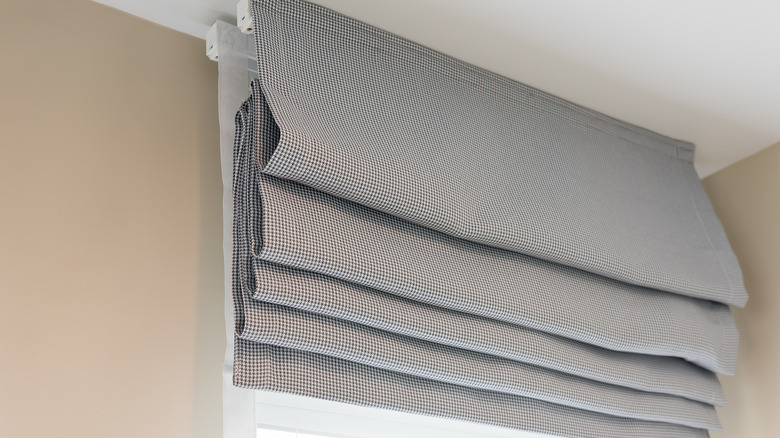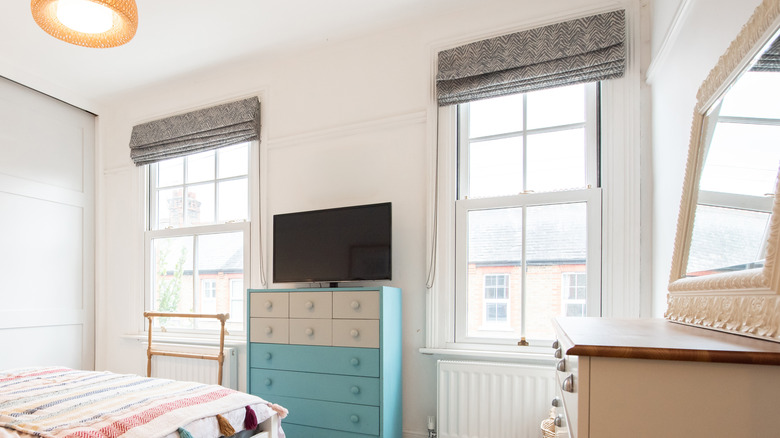Nate Berkus Shares His Go-To Window Treatment & Tips To Simplify The Design Process
We may receive a commission on purchases made from links.
Nothing can date your home faster than the last trend's window treatments. What may have been hot, hot, hot a few years ago can now look positively old-fashioned – that beefy, billowing, over-sized drapery? Tiny, poufy borders topping a huge bay window? Time for an update. Common window treatments range from geometric blinds, both horizontal and vertical, to breezy café curtains. Don't forget about practical, flexible solar panels and blackout curtains, plus lightweight, beachy bamboo shades. Then, of course, there's classic floor-to-ceiling drapes, both stand-alone and layered. Each type of window treatment brings a distinctive flair to your room.
Fortunately, curtains or blinds are easier to switch out than carpeting, furniture, or even paint. Of course, not every room has to have the same type of treatment, but for inspiration, interior designer Nate Berkus shares tips regarding his go-to window treatment. He recommends Roman shades as a classic and sophisticated option for window treatments in a variety of rooms. Advice from the co-host of HGTV's program "The Nate and Jeremiah Home Project" can help you decide on some stylish ways to enhance the glass and screened spaces in your house.
Shade possibilities
Recently on Instagram, Berkus explained that "When it comes to window treatments, one of my favorite options are Roman shades. It can be overwhelming to [choose] from what can feel like endless options." He offers tips to narrow the search for eye-catching window treatments, including his collection of understated, classic Roman blinds seen at The Shade Store.
Note that even the narrowed category of Roman shades offers many options. Chief among these choices is the shape, or the fold. Berkus explains that a flat fold — straight across the shade — has a tailored, buttoned-down look which is very different in appearance from the balloon shade, which is more relaxed and a touch more romantic. "An inside mount within the window frame is what I always do," he says. "I like the shade inside the window, not on the mounting frame. This is best for darkening the room."
His collection is a great way to begin the decision making process for the type, color and texture of the Roman shades you may want to in your home. Choices in Berkus' collection range from soothing gray and neutral tweeds to appealing, super-subtle patterns.
Convenient and stylish then and now
Roman blinds actually were used in ancient Rome, so they've been a helpful element of household maintenance for about 2,000 years. The Roman blinds we know today were more or less re-invented in the late 1800s and have been a fixture in homes throughout Europe and the U.S. for nearly 200 years. Their usefulness in shading light, allowing air exchange, and repelling insects are the reasons they've been used throughout recent decades and why we still love having them today.
Currently, you can purchase these blinds with a traditional pull cord, but cordless Roman shades are also available, which are much better for households with small children and pets. There are also motorized cordless shades that can work with your home's AI, like Alexa. It's no wonder that Roman shades are experiencing a resurgence in 2024 as designers and suppliers bring their simple style and maximum effectiveness into today's homes.
In his semi-autobiographical book, "The Things That Matter," Berkus laid out one of his most enduring design philosophies: "Your home should tell the story of who you are and be a collection of what you love." As Berkus' perspective is quintessentially an American take on elegant, time-honored classics and effortless style, it's no wonder that Roman shades are one of his go-to window treatments throughout the design process.


